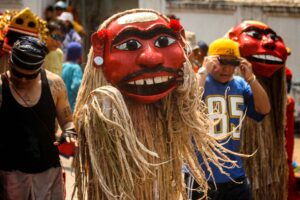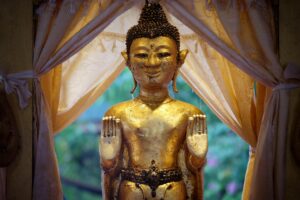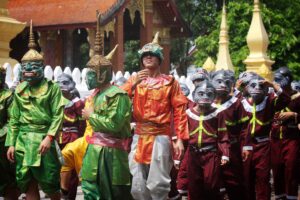Ring in the New Year – Lao Style
In April, Laos partakes in the biggest and wettest street bash of the year. This is the main event of the holiday calendar and it’s an especially large event in Luang Prabang. It might seem strange to hold New Year in April but Laos follows a traditional calendar and is closely tied to the vernal equinox.
Rituals abound over the holidays, particularly involving water, as it’s the time to cleanse, purify and wash the old year’s bad luck away. People like to pour water over other people while recanting a new year’s wish, and it is poor form to refuse. Your valuables will get wet, so put them in a plastic bag, wrap your camera in something waterproof and prepare to be soaked. Policemen, nuns, monks, and grannies are not exempt from the water throwing, so be gracious and accept the libation. Flour, food coloring, and black pan grease could also grace your clothing, so don’t wear your best outfit. The timing is apt as April is the hottest month of the year, it feels refreshing having someone pour icy cold water on you while wishing a sabaidee pi mai (Happy New Year).

Officially spread over three days from 14 to 16 April, the real celebrations often last about a week. Local belief dictates that the first day of celebration is the last day of the old year, the middle day is a day in limbo between both years, and the final day is the first day of the New Year.
In Luang Prabang, on 13 April, a day before the official holiday starts, an elephant procession starts in the morning from Wat Mai to Wat Xieng Thong. Elephants are significant in the history of Laos and this event symbolizes their training for battle. Throughout this period, people also visit their local temples to wash the Buddha images to build merit and even hold family gatherings at a spot such as Kuangsi Waterfall.
On the first official day (14 April), a street fair is held at the town’s main junction where you can find heaps of waterproof pouches for your essentials, sunglasses, floral shirts, and water guns, all de rigueur for the festival. You might notice the local dress code, it’s become a tradition to wear bright flowery shirts and if you are a couple, matching shirts.
Later that afternoon, the party moves out into the Mekong when people take boats to a sandy island to build sand stupas which are decorated with flowers and banners. This stems from a Buddhist tale where each grain of sand used to build a stupa will absolve one sin.

The second day is the day suspended between the old year and the new. An afternoon parade makes its way down the main street to Wat Xieng Thong. Composed of different ethnic groups in costume, various business organizations, and a large quotient of orange-clad monks, the procession is a lively affair and most of the town turns out to watch and throw water on the participants. Elements from traditional folklore such as the ancestor spirits of Luang Prabang, Pou Nyeu and Nya Nyeu, as well as masked Ramayana dancers from the Phalak Phalam Theater also walk the route, usually accompanied by beating drums and music.
Each year, local girls vie for the prestigious Miss New Year title Nang Sangkhan and the chance to ride atop the most eye-catching float of the parade. At the end of the procession, she comes riding a giant animal, including tigers, peacocks, buffalo, a garuda, and even a donkey. Symbolically, she represents one of the seven daughters of King Kabinlaphom, and this year she will be the manifestation of Princess Kirinithevi. She will be standing atop an elephant, wearing emerald green, holding a mahout’s hook in her right hand and a gun in her left hand. The animal, the way she is sitting or standing, what colors she wears, and what she holds in her hand are significant and determined by detailed astrological calculations. After the procession, many people drive around and engage in water fights from trucks and motorbikes and visit friends’ houses to splash water, exchange blessings, and enjoy a beer.

On 16 April, the final day starts early with giving alms to the monks as they walk through town. If you are feeling energetic you can climb to the top of Phou Si Hill to make offerings of sticky rice to the spirits. In the afternoon, the previous day’s procession returns in the opposite direction from Wat Xieng Thong up the main street, while people continue to throw water and party in their homes, as well as hold baci blessing ceremonies to bring good luck for the new year. The evening hosts a special procession of lanterns that descends Phou Si Hill at dusk, while masked dancers perform scenes from the Ramayana for the public.
The following day, calmer, more serious activities take place. Laos’ most venerated Buddha image, the Prabang, is paraded from its home at the Haw Prabang to Wat Mai, where a pavilion is set up to protect the golden statue. For the next three days, locals and visitors offer flowers and candles, pour water over the statue, and pray for blessings. Do remember to dress appropriately; women should wear sinh skirts and everyone must wear a shoulder scarf to participate and build good karma for the coming year.

Text by Anita Preston
Photographs by Anita Preston / Evensong Film



 ລາວ
ລາວ
